| Ðóññêèé / English |
|

|
NUCLEAR SAFETY INSTITUTE OF THE
RUSSIAN ACADEMY OF SCIENCES
|
PREPRINTS
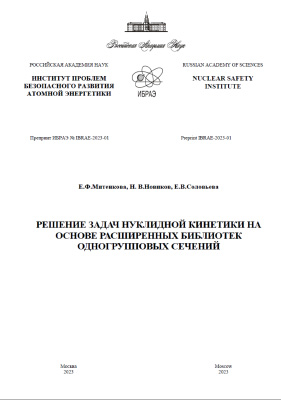 | Nuclide kinetics solving problems with extended single-group cross sections libraries Preprint IBRAE-2023-01 E.F. Mitenkova, N.V. Novikov, E.V. Solovjeva The ambiguous compilation of extended libraries with high-threshold reactions can result in noticeable nuclide composition differences in accurate calculations of nuclide kinetics problems. The importance of high-threshold reactions inclusion in libraries is confirmed by methodical calculations using MZK program. The extended libraries effect on irradiated steel ChS-68 and EK-181 composition is analyzed. Bibliographical reference Nuclide kinetics solving problems with extended single-group cross sections libraries. / E.F. Mitenkova, N.V. Novikov, E.V. Solovjeva — (Preprint / Nuclear Safety Institute RAS, 2023, ¹ IBRAE-2023-01). — Moscow: NSI RAS, 2023. — 19 p. — Bibliogr.: 9 items. — ISBN 978-5-907375-13-0. © Nuclear Safety Institute, 2023 |
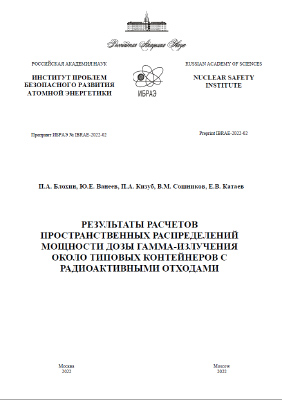 | Calculations of the spatial distributions of gamma dose rates for typical containers with radioactive waste Preprint IBRAE-2022-02 P.A. Blokhin, Yu.E. Vaneyev, P.A. Kizub, V.M. Soshnikov, Å.V. Kataev In this work calculations of the spatial distributions of gamma dose rate near typical radioactive waste containers are performed. Calculations are carried out using TDMCC. Transport and storage containers are considered with different waste containing 137Cs and 60Co (light concrete, porous concrete, soil). Dose rate values presented in tabular and graphical forms correspond to the points at the container surface and at distances up to 2 meters in radial and axial directions and are normalized to unit and integral activity. Examples of using these normalized values to determine dose rates at different distances from container surface for different input data are given. Bibliographical reference Calculations of the spatial distributions of gamma dose rates for typical containers with radioactive waste / P.A. Blokhin, Yu.E. Vaneyev, P.A. Kizub, V.M. Soshnikov, Å.V. Kataev. Preprint IBRAE-2022-02. — Ìoscow: Nuclear Safety Institute, 2022. — 30 p. — Bibliogr.: 14 items. — ISBN 978-5-907 375-05-5. © Nuclear Safety Institute, 2022 |
 | Results of the Build-up Factors Calculations using the precision code for the Infinite Medium Compared to Referenced Data Preprint IBRAE-2022-01 Yu. E. Vaneyev The results of build-up factors calculations in the tasks with point and flat isotropic gamma radiation sources in the infinite medium of iron using the precision code TDMCC are presented. The ranges of energy and optical thickness values are detected where relative deviations of calculated and referenced build-up factors are within ± 1%. Outside those ranges, sufficient understating of calculated build-up factors values (up to 90%) is found, connected to differences in gamma radiation interaction constants when getting referenced data and calculations by TDMCC code. The relations for correct comparison of calculated build-up factors with referenced data are recommended during a verification of code for gamma radiation shield parameters calculation. Bibliographical reference Vaneyev Yu. E. Results of the Build-up Factors Calculations using the precision code for the Infinite Medium Compared to Referenced Data. Preprint IBRAE-2022-01. — Moscow : Nuclear Safety Institute, 2022. — 13 p. — Bibliogr.: 19 items. — ISBN 978-5-6041296-9-2. ©Nuclear Safety Institute, 2022 |
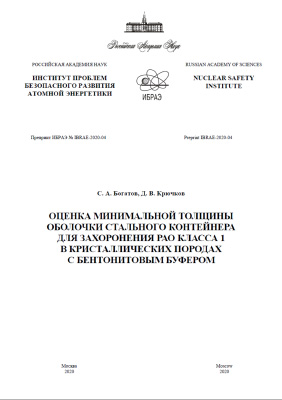 | Estimation of the minimum shell thickness of a steel container for disposal of class 1 radioactive waste in crystalline rocks with a bentonite buffer (Preprint IBRAE-2020-04) Preprint IBRAE-2020-04 S. A. Bogatov, D. V. Kryuchkov The placement of Class 1 radioactive waste in crystalline rocks in carbon steel containers surrounded by a bentonite buffer is considered as one of the possible concepts in the design of the Russian deep disposal site for radioactive waste (PGZRO). Several fundamental issues of this concept are considered - determination of the minimum thickness of a carbon steel container according to the criteria of mechanical strength, taking into account the effect of a bentonite buffer and corrosion. Preliminary computational estimates of the thickness of the bentonite buffer were carried out according to the criterion of the minimum required swelling pressure. Bibliographical reference Bogatov S. A., Kryuchkov D. V. Estimation of the minimum shell thickness of a steel container for disposal of class 1 radioactive waste in crystalline rocks with a bentonite buffer. Preprint IBRAE-2020-04. — Moscow : Nuclear Safety Institute, 2020. — 29 p. — Bibliogr.: 45 items. — ISBN 978-5-6041296-9-2. © IBRAE, 2020 |
 | On the issue of amendments to the Federal Law of January 9, 1996 No.3-FZ “On radiation safety of population” (Preprint IBRAE-2020-03) Preprint IBRAE-2020-03 M. V. Vedernikova, I. I. Linge, S. V. Panchenko, S. V. Strizhova, O. A. Supotaeva, S. S. Utkin The paper describes the reasoning behind the adoption, as well as subsequent regulatory application of the Federal Law of January 9, 1996 No.3-FZ “On radiation safety of population”. Analysis is provided for in-force edition of the Law and for the prospects of its future application and development. Two possible options are considered. The first and the preferable option is to revoke the document due to its very low regulatory effect. The second option (in the case the first option would not be acceptable) is to develop amendments and modifications for the Law. Bibliographical reference Vedernikova M. V., Linge I. I., Panchenko S. V., Strizhova S. V., Supotaeva O. A., Utkin S. S.On the issue of amendments to the Federal Law of January 9, 1996 No.3-FZ “On radiation safety of population”. — (Preprint / Nuclear Safety Institute RAS, ¹ IBRAE-2020-03). — Moscow: Nuclear Safety Institute RAS, 2020. — 22 p. — Bibliogr.: 20 items. . — ISBN 978-5-6041296-5-4. © IBRAE, 2020 |
 | Conceptual Site Model as an Example of Best Practices in Remediation (Preprint IBRAE-2020-02) Preprint IBRAE-2020-02 I. L. Abalkina, S. V. Panchenko The paper describes the main principles for development and use of conceptual site model (CSM), which is widely recognized as a tool for remediation decision making. Based on the analysis of various guidelines, the paper considers CSM goals, evolution, information requirements, application in remediation process. Bibliographical reference Abalkina I. L., Panchenko S. V. Conceptual Site Model as an Example of Best Practices in Remediation. — (Preprint / Nuclear Safety Institute RAS, ¹ IBRAE-2020-02). — Moscow: Nuclear Safety Institute RAS, 2020. — 49 p. — Bibliogr.: 74 items. — ISBN 978-5-6041296-7-8. © Nuclear Safety Institute, 2020 |
 | Radioactive contamination of the ground at the construction site of the Southeast Chord: assessment and projections of radiation safety of the population (Preprint IBRAE-2020-01) Preprint IBRAE-2020-01 D. V. Aron, Å. À. Ilyichev, V. P. Merkushov, I. I. Linge, Å. Ì. Melikhova, S. V. Panchenko, À. Ì. Shvedov, À. V. Shikin The paper presents the results of the analysis of the existing radiation situation and projection for the case of the construction of a section of the Southeast Chord near the borders of the Moscow Polymetal Plant. The environmental conflict that arose in 2019 is considered from the standpoint of radiation safety and risk communication. In addition to purely scientific results, the preprint provides a general description of the radiation situation in the city, the basic principles for ensuring radiation protection of the population in case of detection of radiation anomalies, and briefly describes the city’s radiation safety provision system. The paper is supplemented with links allowing a better understanding of the scale of radiation risks, and they are negligible in comparison with other technological risks that accompany the life of Muscovites. The publication is designed for a wide range of readers - from narrow specialists to public figures and environmental activists. Bibliographical reference Aron, D. Radioactive contamination of the ground at the construction site of the Southeast Chord: assessment and projections of radiation safety of the population / D. V. Aron, Å. À. Ilyichev, V. P. Merkushov, I. I. Linge, Å. Ì. Melikhova, S. V. Panchenko, À. Ì. Shvedov, À. V. Shikin — (Preprint / Nuclear Safety Institute RAS, April 2020, ¹ IBRAE-2020-01). — Moscow: NSI RAS, 2020. — 44 p. — Bibliogr.: 120 items — ISBN 978-5-6041296-3-0 |
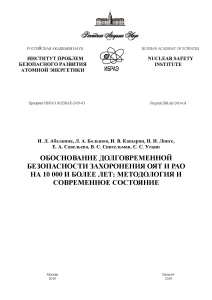 | Radioactive Waste and Spent Nuclear Fuel Deep Geological Disposal Long-Term Safety Assessment for 10 000 Years and Over: Methodology and The Current State (preprint IBRAE-2019-03) Preprint IBRAE-2019-03 I.L. Abalkina, L.A. Bolshov, I.I. Linge, S.S. Utkin, E.A. Saveleva, V.S. Svitelman, I.V. Kapyrin This paper considers the main aspects of the safety case methodology for deep geological disposal of radioactive waste and spent nuclear fuel. The paper shows that the required predictive capability associated foremost with the large timeframes is at least does not exceed similar requirements for safety analysis of reactor facilities. The main focus is the analysis of the list of significant for deep geological disposal Features, Events, Processes, development of the relevant evolution scenarios based on this list and corresponding computation tools for their assessment. The associated knowledge management issues are also touched upon. The material takes into account the best international practices and could benefit a wide range of experts in the area of nuclear fuel cycle long-term safety analysis. Bibliographical reference Abalkina I. L., Bolshov L. A., Kapyrin I. V., Linge I. I., Saveleva E. A., Svitelman V. S., Utkin S. S. Radioactive Waste and Spent Nuclear Fuel Deep Geological Disposal Long-Term Safety Assessment for 10 000 Years and Over: Methodology and The Current State. Preprint IBRAE-2019-03 — Moscow: Nuclear Safety Institute, 2019 — 40 p. — Bibliogr: 84 items. |
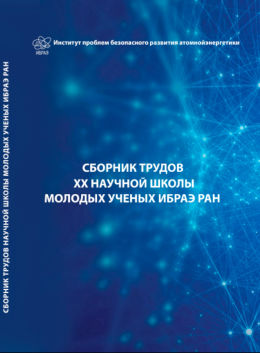 | Proceedings of the Twentieth Scientific School of NSI RAS Young Scientists (Preprint IBRAE-2019-02) Preprint IBRAE-2019-02 This volume contains reports presented at the Twentieth Conference of NSI RAS Young Scientists, held September 12—13, 2019. The authors are students, postgraduate students and young specialists learning and working at the Nuclear Safety Institute as well as participants from other institutes working in adjacent directions. The presented reports cover the most part of scientific activity aspects of the Institute. They are devoted to the problem of severe accidents at NPP, ecological problems, numerical modeling methods, probabilistic safety analysis, information technologies, and economics of energy industry. Bibliographical reference Proceedings of the Twentieth Scientific School of NSI RAS Young Scientists, held September 12—13, 2019. – (Preprint / Nuclear Safety Institute RAS, September 2019, ¹ IBRAE-2019-02). – Moscow: NSI RAS, 2019 – 168 ð. – ISBN 978-5-9907220-1-9. © Nuclear Safety Institute, 2019 |
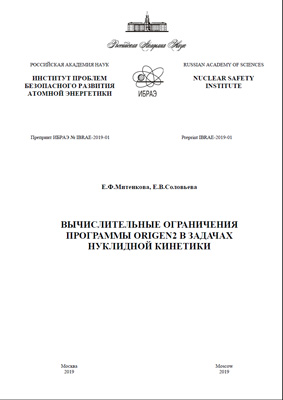 | Computational restrictions of ORIGEN2 code in solving the nuclide kinetics problems (preprint IBRAE-2019-01) Preprint IBRAE-2019-01 Mitenkova, E.F., Solovjeva E.V. This paper presents the ORIGEN2 code features when solving the nuclide kinetics problems using all fission products with independent yields. It is shown the impossibility to obtain the reliable solutions with the guaranteed accuracy for all calculated nuclides by ORIGEN2 code. The calculation results using MZK program to solve stiff ODE systems, based on SADEL solvers library (Bauman Moscow State Technical University), are presented. The MZK program is adapted to solve the nuclide kinetics problems, providing reliable solutions with guaranteed accuracy for all calculated nuclides. Bibliographical reference E.F. Mitenkova, E.V. Solovjeva. Computational restrictions of ORIGEN2 code in solving the nuclide kinetics problems / Preprint IBRAE-2019-01. — Moscow: NSI RAS, 2019. — 31 p. — Bibliogr.: 15 items. © Nuclear Safety Institute, 2019 |
 |
IBRAE RAN © 2013-2026 | Site map | Feedback |